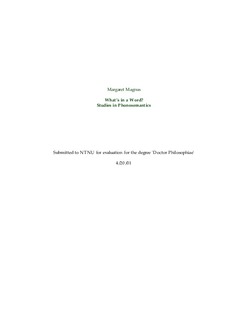| dc.description.abstract | The notion that there is a regular correlation between the form of aword and its meaning is, of course, controversial. In this dissertation my intention has been to shed light on that controversy by conducting a variety of tests -- for the most part on a fairly large scale -- which quantify the extent of the correspondence between sound and meaning in words. I found in the course of this project that phonosemantic correlations were much more pervasive than I initially anticipated and certainly greater than is generally supposed in the linguistics literature. Furthermore, I cannot but see that these tests show that quite general natural laws are productively operative in language which account for most of the correlations observed. If further research indeed corroborates my findings, then it follows that the meaning of every word in every language is in part (only in part!) inherent in its form. The sign is therefore not wholly arbitrary, and it is not possible to devise an abstract representation of language which is entirely unrelated to the form of language itself. The most important results of the experiments in this dissertation seem to me to be these:
-I find that much confusion regarding linguistic iconism can be attributed to the assumption that 'word semantics' is best understood as 'word reference'. I believe these tests show this presumption to be unhelpful. If a word's meaning is analyzed into components -- only one of which is its referent -- it can be shown that some aspects of a word's meaning are arbitrary and others are not. It's therefore not the case that in some words or languages iconism holds more sway than in others. Rather since all words must have these requisite semantic components in order to function at all, the semantics of any word must be in part predictable from its form and in part not.
- Reference is essentially arbitrary. One cannot predict the referent of a word just by hearing it. In words with more concrete reference, the component of reference is more salient, and the iconic sound-meaning is consequently less salient. Therefore, the apparent effect of the sound-meaning is inversely proportional on the concreteness of the referent.
- Individual phonemes and phonetic features are meaning-bearing. They each have a unique semantics which can be identified by first measuring the semantic disproportions within phonologically defined classes of words and then the converse -- measuring the phonological disproportions within semantic classes. One finds in this way that every word which contains a given phoneme bears an element of meaning which is absent in words not containing this phoneme. One finds further than the effect of the phoneme-meaning varies with the position that the phoneme bears within the syllable. In addition, one finds that all phonemes which have a common phonetic feature also have a common element of meaning.
- It is important to distinguish types of sound-meaning correlations:
- The least fundamental kind of sound-meaning correlation is conomatopoeia. It does not concern me in this dissertation.
- The type of correlation which accounts for the 'phonesthemes' or disproportions between semantic classes and phonological form is most commonly called 'Clustering'. I refer to it also as Phonosemantic Association in order to emphasize that it is a side-effect of a natural and productive tendency in human psychology to associate any form with a coherent referent.
- The most fundamental and least salient type of linguistic iconism I will refer to as 'True Iconism', or the level on which form and content are one. This type of correlation is universal, productive in every word, non-arbitrary, and blind to all higher level linguistic distinctions such as referent, part of speech, semantic class and argument structure.
I believe this dissertation provides stronger evidence for these 4 findings than any I have come across anywhere in the existing literature. | nb_NO |
